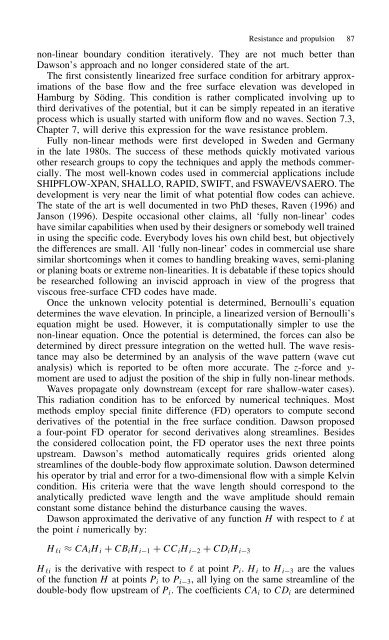Practical Ship Hydrodynamics
Practical Ship Hydrodynamics
Practical Ship Hydrodynamics
You also want an ePaper? Increase the reach of your titles
YUMPU automatically turns print PDFs into web optimized ePapers that Google loves.
Resistance and propulsion 87<br />
non-linear boundary condition iteratively. They are not much better than<br />
Dawson’s approach and no longer considered state of the art.<br />
The first consistently linearized free surface condition for arbitrary approximations<br />
of the base flow and the free surface elevation was developed in<br />
HamburgbySöding. This condition is rather complicated involving up to<br />
third derivatives of the potential, but it can be simply repeated in an iterative<br />
process which is usually started with uniform flow and no waves. Section 7.3,<br />
Chapter 7, will derive this expression for the wave resistance problem.<br />
Fully non-linear methods were first developed in Sweden and Germany<br />
in the late 1980s. The success of these methods quickly motivated various<br />
other research groups to copy the techniques and apply the methods commercially.<br />
The most well-known codes used in commercial applications include<br />
SHIPFLOW-XPAN, SHALLO, RAPID, SWIFT, and FSWAVE/VSAERO. The<br />
development is very near the limit of what potential flow codes can achieve.<br />
The state of the art is well documented in two PhD theses, Raven (1996) and<br />
Janson (1996). Despite occasional other claims, all ‘fully non-linear’ codes<br />
have similar capabilities when used by their designers or somebody well trained<br />
in using the specific code. Everybody loves his own child best, but objectively<br />
the differences are small. All ‘fully non-linear’ codes in commercial use share<br />
similar shortcomings when it comes to handling breaking waves, semi-planing<br />
or planing boats or extreme non-linearities. It is debatable if these topics should<br />
be researched following an inviscid approach in view of the progress that<br />
viscous free-surface CFD codes have made.<br />
Once the unknown velocity potential is determined, Bernoulli’s equation<br />
determines the wave elevation. In principle, a linearized version of Bernoulli’s<br />
equation might be used. However, it is computationally simpler to use the<br />
non-linear equation. Once the potential is determined, the forces can also be<br />
determined by direct pressure integration on the wetted hull. The wave resistance<br />
may also be determined by an analysis of the wave pattern (wave cut<br />
analysis) which is reported to be often more accurate. The z-force and ymoment<br />
are used to adjust the position of the ship in fully non-linear methods.<br />
Waves propagate only downstream (except for rare shallow-water cases).<br />
This radiation condition has to be enforced by numerical techniques. Most<br />
methods employ special finite difference (FD) operators to compute second<br />
derivatives of the potential in the free surface condition. Dawson proposed<br />
a four-point FD operator for second derivatives along streamlines. Besides<br />
the considered collocation point, the FD operator uses the next three points<br />
upstream. Dawson’s method automatically requires grids oriented along<br />
streamlines of the double-body flow approximate solution. Dawson determined<br />
his operator by trial and error for a two-dimensional flow with a simple Kelvin<br />
condition. His criteria were that the wave length should correspond to the<br />
analytically predicted wave length and the wave amplitude should remain<br />
constant some distance behind the disturbance causing the waves.<br />
Dawson approximated the derivative of any function H with respect to ℓ at<br />
the point i numerically by:<br />
Hℓi ³ CAiHi C CBiHi 1 C CCiHi 2 C CDiHi 3<br />
Hℓi is the derivative with respect to ℓ at point Pi. Hi to Hi 3 are the values<br />
of the function H at points Pi to Pi 3, all lying on the same streamline of the<br />
double-body flow upstream of Pi. Thecoefficients CAi to CDi are determined
















